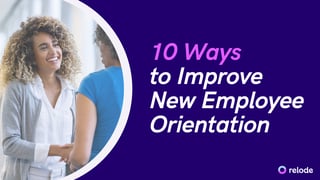Statistics reveal that 22% of employee turnovers occur within the first 45 days. And 90% of employees decide whether to stay or leave a new company within their first six months.
Your onboarding process and orientation are crucial for capturing a new hire’s loyalty in this short window of opportunity. But fail to do so, and your team will need to restart the sourcing and recruiting process.
This article explores how to improve your new employee orientation and integrate your next hire for success.
Before we share our tactics, let’s begin by clarifying the difference between:
New employee orientation vs. employee onboarding
Though sometimes used interchangeably, employee orientation introduces new hires to your organization on their first day, while employee onboarding describes the process of transitioning new hires into their roles.
The onboarding process includes orientation. Both onboarding and orientation share the same goal: to integrate new hires into your organization and unite them with your employees and company culture.
What is employee onboarding?
- It begins when your candidate signs their offer letter and ends when they can autonomously perform their job.
- It helps employees learn their job duties, start formal job training, settle into their roles, and meet expectations.
- It may last weeks, months, or up to one year.
Employees who participate in onboarding programs that last up to a year attain full job proficiency 34 times faster than those in shorter programs.
What is employee orientation?
- A new hire’s first days that introduces them to their workplace, team, role, and organization.
- It helps new hires get comfortable and start thinking in terms of “us” as they align with company policies and company culture.
- Depending on the industry and job, it may last a few hours, a full business day, or up to one week.
An onboarding process incorporating a stellar employee orientation sets the tone for how your organization treats and values its team members.
However, 22% of employers do not have a new hire orientation process. Let’s discuss why that’s a missed opportunity and a significant mistake.
Why is new employee orientation important?
Orientation establishes your relationship with new employees and affirms their decision to accept employment with your organization. The quicker your new hires feel comfortable and aligned with your company, the sooner they will be engaged, productive team members.
The benefits of an effective employee orientation include the following:
Employee belonging
Belonging in the workplace means employees feel welcomed and valued by their organization and coworkers and feel psychologically safe to bring their whole selves to work.
The number one goal of employee orientation is to reduce a new hire’s stress and anxiety. New hires are always nervous about whether they’ll be accepted in a different work environment. Orientation should help them feel supported, appreciated, and excited to join the team. These values increase employee loyalty and drive engagement and retention.
Higher engagement, productivity, & revenue
New hire orientation empowers organizations to leverage a candidate’s excitement about a role and the company to accelerate learning. New hires should feel comfortable asking questions and engaging to become productive contributors.
According to research:
- 51% of employees admit they’d go “above and beyond” for a company if they received a good introduction and onboarding.
- Organizations with effective orientations have 33% more engaged employees than those with ineffective ones.
- A robust onboarding process improves new hire productivity by over 70%.
- 66% of companies credit their orientation programs for successfully assimilating new hires into their company culture.
- Highly-engaged employees are 40% less likely to look for another job.
Engaged, productive employees drive revenue for their organizations. A staggering 78% of organizations that invested in onboarding reported higher revenue than those least invested. Of those organizations, 64% saw positive gains in their organizational KPIs, and 54% achieved significant increases in employee engagement metrics.
Lower turnover & higher retention rates
An excellent employee orientation shows new hires that your organization cares about them and is invested in their success. This positive sentiment breeds loyalty that prevents employees from looking for opportunities elsewhere. New employee retention data demonstrates that:
- New hires may be 18 times more committed to their employer after a good onboarding process.
- Organizations with a strong employee onboarding program improve employee retention by 82%.
- 58% of employees who undergo a structured orientation process are more likely to remain with the company after three years.
Conversely, new hires with poor employee orientations often feel uncomfortable in their new roles or teams. As turnover research shows:
- ~17% of employees leave their job within the first week; ~18% leave within the first month.
- Nearly 33% of new hires look for a new role within their first six months; 31% quit after six months.
- A negative onboarding experience doubles the odds that an employee will seek another opportunity.
Unfortunately, only 12% of employees describe their companies' onboarding and orientation processes as “great.” To fix this huge issue, organizations must learn:
10 tips to improve new employee orientation
Your employee orientation checklist should include everything new hires need to familiarize themselves with your organization’s policies, company culture, team members, and leaders. Your strategy should also help new hires get comfortable with the tools, software, and other workplace equipment your employees use most.
To improve your new employee orientation process:

1. Welcome new hires & alleviate first-day nerves
You can leverage a new employee’s enthusiasm and excitement after they receive their job offer to build positive momentum. To do this:
Send your new hires a welcome package with items like:
- A signed welcome note from the CEO or their direct manager
- Company-branded items (mugs, t-shirts, water bottle, etc.)
- Samples of your products or free access to your service
Your new hire will be surprised and feel appreciated when this welcome package arrives on their doorstep. And stats show 57% of employees said they’re more likely to be loyal and continue working for a company that provides gifts.
Alleviate first-day anxiety. Ease your new hire’s stress with a head’s up about what to expect on their first day. Share information in their welcome package, such as a/an:
- Copy of your orientation checklist and first-day agenda
- Map of the parking facilities and parking pass
- Guide to local public transportation
- Office map
- Recommendation for nearby coffee shops
- Guideline for the dress code
- List of what they’ll need to bring (such as a photo ID)
This package of goodies and intel creates a fantastic first impression and affirms that your new hire’s decision to join your team was correct.
2. Automate your pre-boarding
Pre-boarding or pre-orientation refers to engaging with your new hire after they accept the position and before their first day on the job. Over 83% of high-performing companies begin onboarding before an employee’s first day to speed up the administrative processes.
Research indicates that the average new hire has 41 administrative tasks to complete. So it’s unsurprising that 58% of organizations say their onboarding program focuses more on processes and paperwork.
Devoting your new hire’s first day to administrative tasks can be overwhelming and exhausting. It also takes time away from building connections with your team. That’s why 83% of employers use employee onboarding solutions. This can help your team:
- Automate onboarding tasks and workflows.
- Eliminate manual, time-consuming paperwork (such as filling out direct deposit forms, signing the employee handbook, etc.).
- Share information about your work policies, compensation and benefits, overtime and PTO, employee conduct, etc.
- Create email logins and set up accounts in your project manager, team communication channels, etc.
- Introduce new hires to your company through interactive online presentations and learning courses.
- Maintain high visibility on your new hire’s progress.
New employees can complete their online onboarding on their own time before their first day. They’ll quickly acclimate to your company culture and jargon before arriving on-site.
When new hires complete employee pre-boarding online prior to their start date, their job satisfaction rises, and their willingness to refer people to their employer increases to 83%.
3. Standardize orientation day
More than 33% of companies lack a structured orientation process.
But standardizing your orientation day ensures each employee receives the same introduction and support to become a productive team member. It also guarantees that anyone on your team can maintain this consistency.
Orientation days vary based on industry, the type of position, and more. Your orientation may last a few hours or one week. Despite these differences, every orientation process should include:
- A schedule/agenda with room for breaks every hour to keep your employee engaged and make information easier to digest and remember.
- A guided workplace tour that highlights common spaces, meeting areas, restrooms, workstations, HR, etc.
- Helpful intel, such as how the coffee machine works and how to request supplies
- Access to an internal knowledge base, so employees know where to locate information if they have questions.
A standardized orientation process shows new hires that your team is organized, competent, and professional.

4. Create a warm team welcome
A warm welcome is the fastest way to make your new hire feel like they’re part of the team. So when they arrive, gather everyone and prepare a speech to introduce your new hire to everyone. Encourage employees to socialize in this neutral, relaxed setting. Then whisk your new hire away to begin your formal orientation checklist.
5. Communicate clearly about your company culture
New employees should become invested in your organization’s mission, core values, and company culture to begin aligning with your goals as soon as possible.
Build on the information your new hires learned during their pre-boarding course to discuss:
- How your organization works
- Roles and team members
- How employees embody your company culture
- Ways your team gives back to the community
- Your business goals and vision for the future
- Daily/weekly/monthly functions ( i.e., Do you hold daily stand-ups, weekly team meetings, annual retreats, etc.?)
Your new hires will better understand what your team’s striving for and how they can add value to your company.
6. Set realistic expectations & provide encouragement
After you outline your company goals, you’ll want to communicate your expectations for your new hire individually.
Ideally, your organization should have presented a realistic job overview in your job ad and during recruitment. Yet in one SHRM study, 23% of employees who quit within six months said that clearer guidelines on their responsibilities would have helped them stay at their job.
So provide an overview of your new hire’s job duties and expectations, such as:
- How their role fits in the organization
- Their day-to-day tasks and responsibilities
- To whom they report to
- What defines success and failure in the role
- How performance will be measured
- Resources available for training
Everyone also needs personal encouragement. Experts recommend employers encourage new hires with motivating statements such as:
We hired you because you excel at X, and we’re counting on you to bring your skills to Y.
7. Match new hires with an orientation partner
Peer mentors or Orientation Buddies support your new hire, helping them break into workplace social circles, learn the ropes, and find their way in your organization.
The Buddy System pairs up an experienced or senior employee with your new hire so they have a go-to when they have questions. You can give your Buddy a cheatsheet of frequently asked questions, so they always know the right things to say. Your Buddy can also check in with your new employee over the first few weeks.
Over 47% of organizations use a Buddy program with new employees. Research demonstrates that:
- Having social support is one of the best ways to cope with stress.
- 87% of organizations believe assigning a mentor or buddy to a new hire increased their new hire’s efficiency and productivity.
- 56% of employees admitted that having a buddy or mentor at work was very important when getting started.
- Employee satisfaction increases by nearly 50% when they develop close relationships at work.
Being in unfamiliar territory when starting any job is stressful, but having someone to talk to reassures new employees that they’re on the right track.
8. Make room for short meet-and-greets
Investing more in communication and engagement can improve the onboarding experience by 83%. So creating meaningful connections during a new hire’s first weeks is essential.
A new employee should have at least one personal conversation with their colleagues, direct manager, and department manager during orientation. It doesn’t have to be long or overly involved, yet it should offer an intimate way to connect and get to know each other.
Schedule time for senior leadership meet-and-greets. Emphasize the importance of team-building in the new employee orientation process to get buy-in from higher-ups with busy schedules.
9. Show new employees that you’re invested
New hires who believe their employers are invested in them are more likely to feel welcome, appreciated, and loyal. Belonging and engagement will rise, and your employees will thrive in their new roles.
To show your organization is invested in its new hires:
- Add your new employee to your website’s Team/About Us page. This instantly makes new hires feel like they’re part of the team. You can grab their photo and bio from LinkedIn, ask for them, or take a headshot in the office.
- Make an announcement on LinkedIn or in your newsletter. Introduce your new colleague to your customers, shareholders, teams working in different offices, etc., to show your excitement.
- Discuss their career goals and growth opportunities. Help your new hire envision their future with your organization. Addressing career development during onboarding more than triples job satisfaction. And employees with a clear professional development plan are 3.5 times more likely to strongly agree that their onboarding process was exceptional.
Listening to feedback and concerns is also part of investing in your new hires.
10. Ask for feedback to improve your orientation process
When employers ask for feedback about the orientation process, new hires are 91% more willing to invest in their relationship. This simple act may help reduce 90-day turnover, improve retention, and optimize your employee orientation process for success in the future.
Gather new hire feedback, sentiment scores, and suggestions as soon as your team completes orientation, and the feelings are fresh in your new hire’s mind. Then try to iterate on this intel next time.
Saving resources through the orientation process
A well-structured new employee orientation increases your organization’s chances of retention, engagement, productivity, and belonging. It will also empower your team to carry new employees across the 90-day turnover threshold while saving time, money, and headaches.
Use our new employee orientation tips to hit your retention goals while addressing the emotional side of breaking into a new organization. You’ll forge long-lasting relationships that help your new hire reach their full potential on your team.
Relode can transform your hiring process and help you find and retain top talent. Schedule a demo today to learn how.
